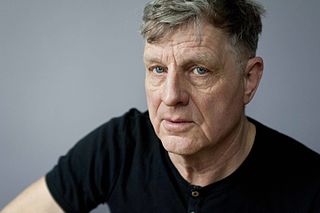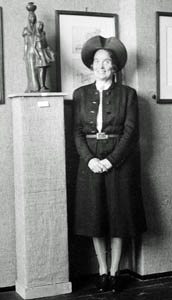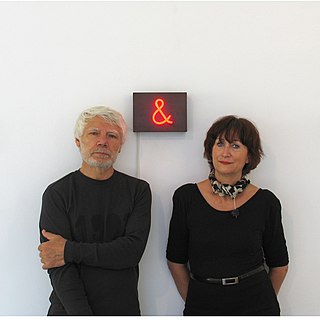Martha Rosler is an American artist. She is a conceptual artist who works in photography and photo text, video, installation, sculpture, and performance, as well as writing about art and culture. Rosler's work is centered on everyday life and the public sphere, often with an eye to women's experience. Recurrent concerns are the media and war, as well as architecture and the built environment, from housing and homelessness to places of passage and systems of transport.
Michael Ruetz works as artist and author. He is a German photographer.

Rainer Fetting is a German painter and sculptor.
Fiona Tan is a visual artist primarily known for her photography, film and video art installations. With her own complex cultural background, Tan's work is known for its skillful craftsmanship and emotional intensity, which often explores the themes of identity, memory, and history. Tan currently lives and works in Amsterdam, the Netherlands.
A K Dolven is a Norwegian artist. She works across painting, film, sound, sculpture and interventions in public space.
Annegret Soltau is a German visual artist, born in Lüneburg, Germany.

Emy Roeder was a modern German sculptor born in Würzburg, Germany. During the first third of the twentieth century she was one of a number of women that were associated with the German Expressionist movement of Modern art. She was the first woman to achieve Master Student of sculpture as a student at the Berlin Academy In 1937 her work was labeled Degenerate art by the Nazis. After World War II she was arrested in Italy by the Allies because she was a German citizen and then sent to an internment camp. She received the Villa Romana prize in 1936, and was awarded the Federal Cross of Merit for her life work in 1960. She died, aged 81, in Mainz.
Barbara Bloom lives and works in New York City. She is a conceptual artist best known for her multi-media installation works. Bloom is loosely affiliated with a group of artists referred to as The Pictures Generation. For nearly twenty years she lived in Europe, first in Amsterdam then Berlin. Since 1992, she has lived in New York City with her husband, the writer-composer Chris Mann, and their daughter.
Hildegard Ochse was a German photographer.

Anna Gaskell is an American art photographer and artist from Des Moines, Iowa.

Nan Hoover was a Dutch/American-expatriate artist who is known for her pioneering work in video art, photography and performance art. She spent almost four decades living and working in the Netherlands. She also used the mediums of drawing, painting, photography and film and created art objects and sculptures. One of the main themes of her art was light and motion. The rigorous, minimalist handling of her means as well as the intense concentration with which she performed within spaces of light and shadow are the most salient characteristics of her artistic work.
Kathrin Sonntag is a visual artist who works in photography, sculpture, film, and installations. Her work has been exhibited in museums including the Kunstverein in Hamburg, Germany and the Solomon R. Guggenheim Museum in New York City.

Sandra Becker is a Berlin-based video artist.

Cornelia Schleime is a German painter, performer, filmmaker and author. Born in East Berlin under the GDR, she studied painting and graphic arts at the Dresden Academy of Fine Arts before becoming a member of the underground art scene.

Molitor & Kuzmin are a collaborative duo of visual artists, who are classified as light art and installation artists.

Karin Apollonia Müller is a German contemporary photographer artist. She has received numerous awards, grants and fellowships. Her work is published, exhibited and is in the following collections: The Whitney Museum of American Art, Museum of Modern Art - New York, Armand Hammer Museum of Art, Los Angeles County Museum of Art among others.
Gertie Fröhlich was a Czechoslovak-born Austrian painter, graphic designer and the initiator of the Galerie nächst St. Stephan in Vienna. She was an important figure in the post-war Austrian painting and experimental film world, where often from behind the scenes she supported numerous artists and institutions.
Vajiko Chachkhiani is a Georgian artist whose work mostly involves film, sculpture, photography and visual installations. Currently he lives and works in Berlin, Germany and Tbilisi, Georgia. Chachkhiani's work has been shown at the Venice Biennale.

Pomona Zipser is a Romanian-born contemporary artist based in Berlin, known for her sculptures. She was born in 1958 in Romania and moved to Germany with her mother in 1970. Zipser studied at the Academy of Fine Arts in Munich and the Berlin University of the Arts.

Isa Melsheimer is a German sculptor, object and installation artist, painter and university lecturer.











